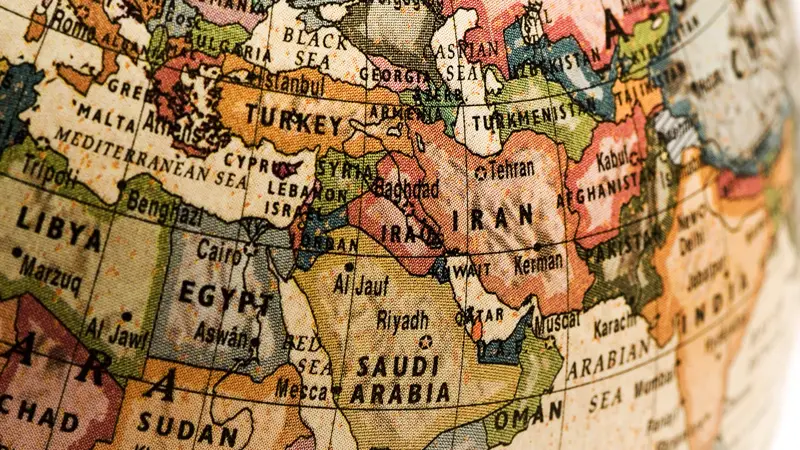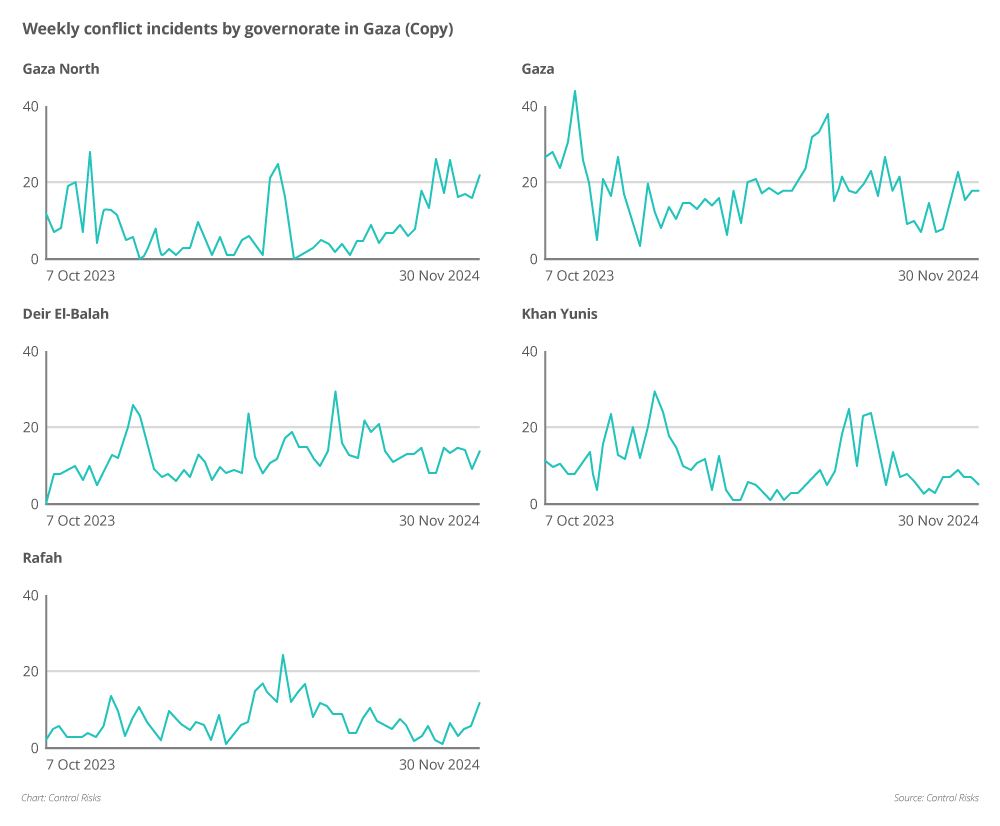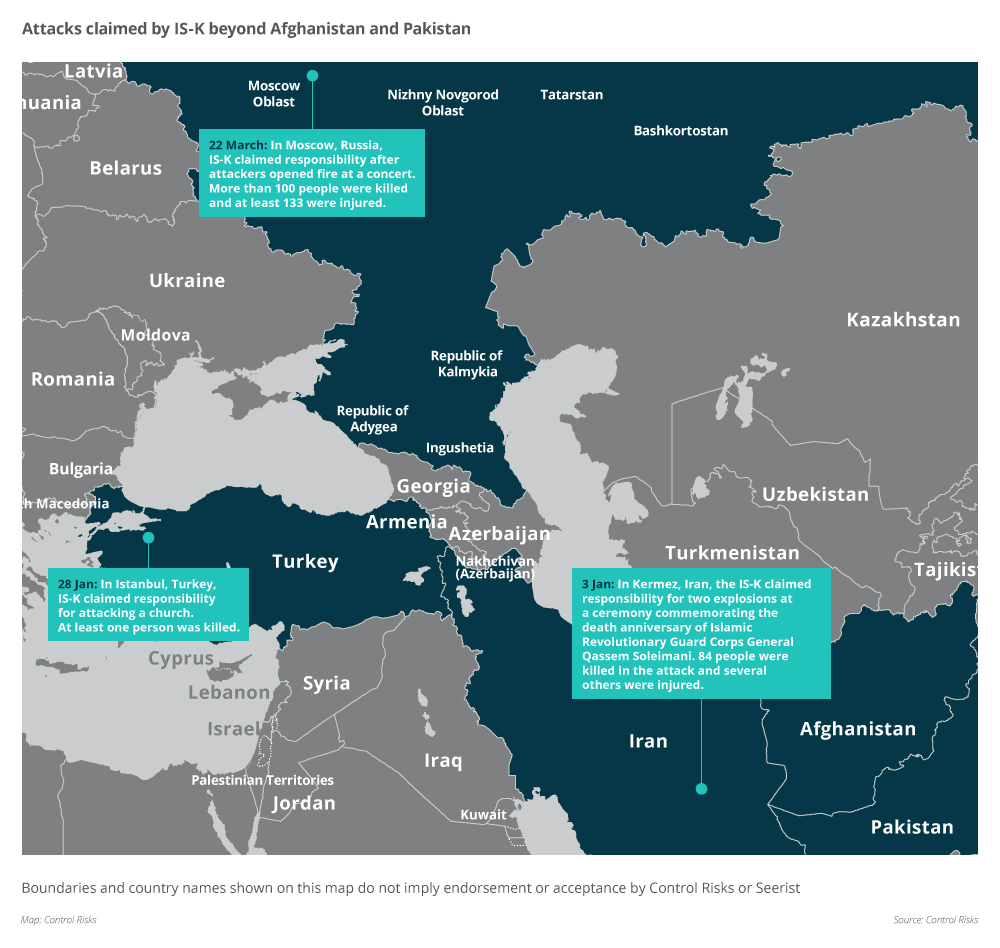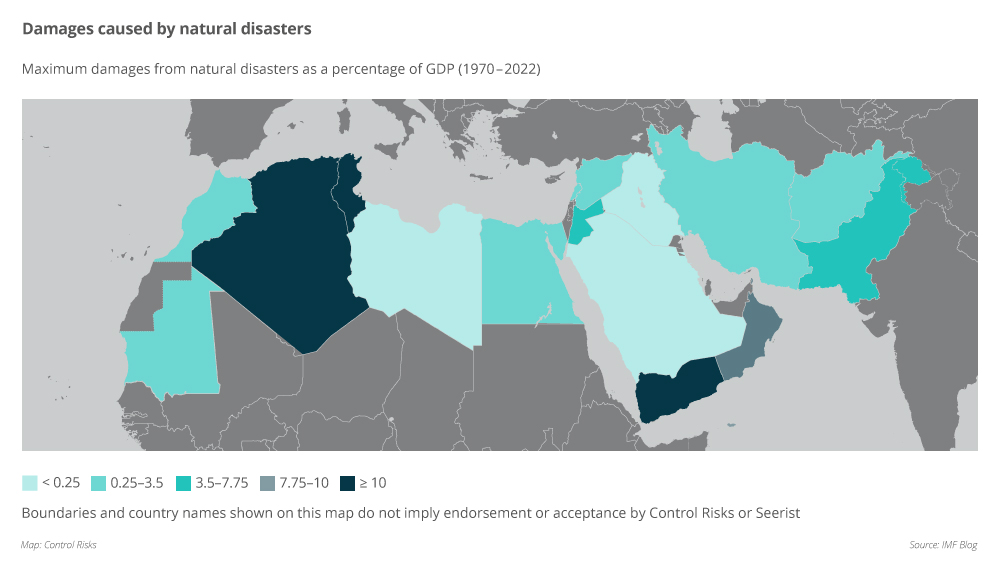

Middle East and North Africa Political and Country Risk
The first phase of a ceasefire between Israel and Hamas was inked on 19 January 2025, with negotiations on the following phases aiming to cement a permanent end to the conflict expected to start by February. Israel has much degraded Hamas' capabilities, and Netanyahu's increasingly secure political position gives him greater latitude to end the conflict in the Gaza Strip.
Nevertheless, significant uncertainty over the long-term status and governance of structures in the Palestinian Territories will likely persist in 2025. Talks between Hamas and Fatah, the dominant group in the Palestinian Authority (PA), kickstarted in November, but it is unclear if they will succeed in bringing a governing body to the Gaza Strip. Israel will likely adopt an increasingly hawkish approach to the Palestinian Territories, maintaining forces in Gaza for much of 2025. Israel will also likely restart efforts to accelerate annexation of parts of the West Bank.
Wild card scenario: two-state solution
Israel, Arab states and the PA make a grand normalisation bargain, brokered by the US and led by Saudi Arabia, with Israel agreeing to terms that guarantee Palestinian statehood on the principles of a two-state solution.

Severely weakened militarily, Iran will likely restrain itself and its proxies from taking aggressive actions against Israel, the US and their allies. More likely, Tehran will engage in diplomacy and back-channel discussion with the US, European countries, and regional actors and try to dissuade US President Donald Trump from adopting a maximum pressure campaign against Iran. Despite Iran's commitment to retaliate for Israel's 26 October attack, Tehran will likely use the ceasefire in Lebanon and Gaza as a justification for not responding.
Tehran will likely aim to leverage its nuclear programme, support for Russia and newly developed relations with countries across the region, including the Gulf. Tehran will also stress that its proxies maintain the capability to retaliate, showing that it is not isolated or deterred and has tools at its disposal should Israel or the US escalate.
Wild card: a grand bargain
The US and Iran strike a grand bargain, which addresses not only the nuclear component, but also Iran's support for proxies and destabilising activities across the region.
Afghanistan will remain a haven for militant groups with regional and global ambitions. Although the Taliban's affiliate, al-Qaida, continues to maintain a low profile, it continues to strengthen its capabilities and deepen its symbiotic relationship with the government. While the Taliban continues to look the other way regarding al-Qaida, it will remain incapable of curbing the Islamic State-Khorasan (IS-K) 's domestic capabilities and intent to mount attacks beyond Afghanistan and Pakistan.
Meanwhile, the fall of the Assad regime in Syria could result in fragmentation that transnational actors like Islamic State (IS) and al-Qaida could seek to exploit. The frequency of IS attacks increased in 2024. As of mid-December, Syrian rebels led by the Islamist group Hayat Tahrir al-Sham (HTS) appear on track to consolidate power, but the state-building process remains in the early stages and fraught with obstacles. A rapid collapse of HTS's authority would immediately benefit transnational terrorist movements by further degrading the security environment and worsening socioeconomic conditions that could improve recruitment prospects.
Wild card: mounting threat

The second Trump administration will centre its regional policies around two pillars: combatting Iranian influence through Maximum Pressure 2.0 and expanding the Abraham Accords. These two policies are not mutually exclusive. Despite Trump's continued criticism of Iran – and his likely anger at FBI reports that Iran was linked to two assassination attempts against him during the election campaign – Trump has said he would consider returning to the negotiating table.
During his first term (2017-21), Trump tried to renegotiate the Iran nuclear deal. Some of his supporters argue that the current environment in the region – where Iran’s regional influence has rapidly retrenched – is the best possible landscape for a deal supporting US interests.
Wild card: pre-emptive strikes
Trump orders pre-emptive strikes on Iran's key nuclear sites, significantly degrading Iran's nuclear enrichment capability.
The Houthi rebel movement in Yemen is likely to cautiously pause its attacks against Israel and US-, UK-, and Israel-linked vessels in the Red Sea while monitoring the Gaza ceasefire agreement. The Houthis are likely to resume attacks in some circumstances, including Israel’s violation or withdrawal from the agreement.
The Houthis represent the last major non-neighbouring proxy group of Iran, and Tehran will likely increase its financial and military support to the group. The Houthis will likely use their bargaining power to mandate conditions on Iran to maintain its decision-making power, particularly regarding its internal affairs and the stalled ceasefire negotiations with Saudi Arabia.
Wild card: peace prevails
The UN-backed peace talks between warring parties begin and quickly progress. Facilitated by Saudi Arabia, the UAE, and Iran, the internationally recognised government—including the successionist Southern Transitional Council—and the Houthis agree on a governing model for Yemen, among other issues. The developments attract businesses into Yemen, increasing the warring parties' access to funds and leading to incremental socioeconomic improvement.
Islamist group Hayat Tahrir al-Sham (HTS) remains in control of the transitional process. HTS's pledge to respect minority rights reflects a bid for international legitimacy. However, questions persist about the unity and governance capacity of HTS-led forces. The group’s leader, Ahmed al-Sharaa, will have to contend with a wide range of competing interests, from retaining the loyalty of Islamist constituencies to securing buy-in from southern rebel factions and minorities.
In north-eastern Syria, the Kurdish-led Syrian Democratic Forces (SDF) control territory east of the Euphrates River, with advanced autonomous governance structures that the group will seek to preserve. The risk of Syria's continued partition remains pronounced, sustained by the ideological rift between the HTS-led opposition, which controls western Syria, and the Kurdish SDF forces, which control eastern Syria.
Wild card: fragmentation to escalation
Trump's isolationist policy reduces the military support provided to the Kurdish-led SDF. Supported by Türkiye, the HTS-led opposition starts a military campaign to drive out SDF forces from the Raqqa, Deir Ezzor and Hasaka provinces.
The MENA region is one of the world's most vulnerable to climate change's impacts. This vulnerability is due to higher temperatures, rising seas, droughts, floods, intense water scarcity and polluted air. Weak state preparedness and planning will lead to significant loss of life and livelihoods and slow reconstruction efforts, which will have a long-term impact on supply chain revivals and export growth.
Climate-vulnerable countries will continue to lobby for transitioning away from fossil fuels to low-emissions economies at multilateral climate conferences. Still, they are unlikely to see concrete commitments from developed nations. Limited resources and lack of financing mean that vulnerable countries in the region will struggle to adapt.
Wild card: progress on financing


Analysis
Trump's Gulf Trip: boost for US and Gulf buisness
© Black Raptor Ops Group Holdings Ltd registration no.01548306